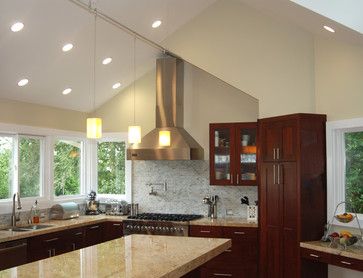When it comes to designing a kitchen with a vaulted ceiling, lighting becomes not just a practical consideration but a key element in enhancing the overall aesthetic and functionality of the space. The unique architectural feature of a vaulted ceiling adds both charm and challenges to lighting design. Properly chosen and placed lighting can transform your kitchen into a welcoming and efficient hub of your home.

Understanding Vaulted Ceilings in Kitchen Design
Vaulted ceilings are known for their spaciousness and ability to create a sense of openness in any room, including the kitchen. They typically feature slopes or angles that can vary in steepness and direction, which greatly impacts how light is distributed throughout the space. This architectural feature often means that standard lighting solutions used in kitchens with regular ceilings may not suffice.
Factors to Consider When Choosing Kitchen Lighting for a Vaulted Ceiling
- Height and Scale: The height of the ceiling and the scale of the kitchen play crucial roles in determining the type and placement of lighting fixtures. Tall ceilings offer opportunities for statement lighting fixtures that not only illuminate but also become focal points in the room.
- Lighting Types: Consider a combination of ambient, task, and accent lighting to meet various needs. Pendant lights, recessed lighting, track lighting, and chandeliers are popular choices for vaulted ceilings, each serving different purposes in enhancing both the functionality and ambiance of the kitchen.
- Natural Light Integration: Vaulted ceilings often allow for larger windows or skylights, which can supplement artificial lighting during daylight hours. Integrating natural light effectively can reduce the need for artificial lighting and create a more open and airy atmosphere.
Key Considerations for Each Type of Kitchen Lighting
- Pendant Lights: Ideal for task lighting over islands or dining areas beneath vaulted ceilings. Choose styles that complement your kitchen’s decor without overwhelming the space.
- Recessed Lighting: Provides ambient lighting evenly throughout the kitchen. Adjust the placement and spacing of recessed lights based on the ceiling’s slope and height for optimal illumination.
- Track Lighting: Offers flexibility in directing light to specific areas. Tracks can follow the slope of the ceiling, highlighting architectural features or specific work zones such as countertops and sinks.
Kitchen Lighting For A Vaulted Ceiling: Practical Tips and Tricks
Achieving balanced and effective lighting in a kitchen with a vaulted ceiling requires careful planning and execution. Here are some additional tips to consider:
- Layered Lighting: Combine different types of lighting to create layers of illumination that can be adjusted according to activities and mood.
- Dimmer Switches: Install dimmer switches to control the intensity of light fixtures, allowing for versatility in lighting and ambiance.
- Lighting Control Systems: Consider smart lighting options that enable remote control and automated settings, providing convenience and energy efficiency.
- Professional Consultation: For complex vaulted ceiling designs or if you’re unsure about lighting placement, consulting with a lighting designer or an interior designer can ensure optimal results.
Conclusion
In conclusion, choosing the right kitchen lighting for a vaulted ceiling involves understanding the unique characteristics of both the space and the lighting fixtures available. By carefully selecting and placing lighting elements, you can enhance the beauty of your kitchen while ensuring it remains a functional workspace. Whether you opt for pendant lights, recessed lighting, or a combination of several types, each choice contributes to creating a well-lit and inviting kitchen environment.
Explore your options, consider your needs, and let your kitchen’s vaulted ceiling shine with the perfect lighting solution.
Read too: Striped Schoolhouse Ceiling Light Fixtures: Unveiling the Timeless Charm